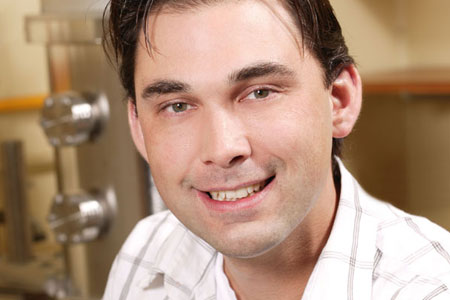Instruments developed at the U of S headed for stratosphere
Shoulders brush the wall as visitors climb a tight spiral staircase to the top floor of the Physics Building, into a technological wizard’s lair where Adam Bourassa, Michael Bradley and their team are developing instruments to study the Earth’s upper atmosphere.
By Michael Robin What they learn will inform broad questions on climate change to everyday applications such as more accurate weather prediction and urban smog alerts.
What they learn will inform broad questions on climate change to everyday applications such as more accurate weather prediction and urban smog alerts.
The two associate professors in Department of Physics and Engineering Physics have just received the green light for their two instruments to ride on a stadium-sized balloon into the stratosphere as part of a joint mission of the Canadian Space Agency and France's Centre national d'études spatiales. The launch, scheduled for June near Timmins, Ontario, will test the instruments' capabilities and durability.
"The environment in the stratosphere is similar to space," Bourassa explained. It features extreme heat from sunlight, extreme cold from space and an unhealthy dose of cosmic radiation.
"There's really no good way to simulate these conditions on a lab bench."
The bench in the satellite assembly room hisses faintly as automatic dampers activate, designed to eliminate vibration from errant elbows and the building itself. Two instruments under construction—ALI (Aerosol Limb Imager) and OSIRIS-DM—are screwed securely to the threaded holes on its stainless steel top.
Bradley explained that ALI employs the "acousto-optic" effect, which uses sound waves in a precision-manufactured crystal to diffract light passing through the atmosphere. Analyzing the light gives a picture of the atmosphere and tiny particles—
aerosols—within it. It is a new approach to measurement.
"This will be the first space application for aerosol imaging of an acousto-optic imager that we know of," Bradley said. "Technology wise, it's pretty ground-breaking."
OSIRIS-DM (Optical Spectrograph and InfraRed Imager System-Developmental Model) is designed to measure ozone, nitrogen dioxide (a component of smog), as well as particulates in the atmosphere from human activities or natural sources such as volcanoes. Bourassa said the instrument is intended to replace the current OSIRIS, which has been flying on Sweden's ODIN satellite for the past decade.
"OSIRIS is now 10-year-old technology. It's making good measurements, but scientifically for weather and climate, the needs are for higher-resolution measurements," he said. OSIRIS-DM is designed to deliver three to five times the resolution of its predecessor.
This summer's mission will be a shakedown of the instruments themselves to see how they perform, but also an opportunity to gather valuable research data.
"All of these instruments are being studied by the space agency for a new satellite mission within about a three or four-year timeline," Bourassa said. "They're all built to measure a key unknown component of atmospheric composition and climate change."

